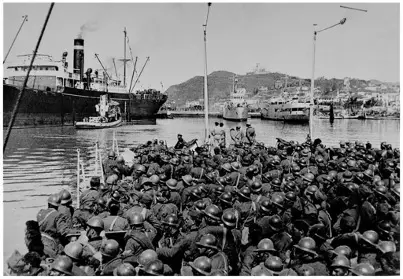The Italian occupation of Albania in April 1939 is perhaps one of the most overlooked pre-war events. Although quick and with almost no international reaction, this event is quite important to understand several aspects of the Italian involvement in WW2.
Context
In March 1939, Nazi Germany put an end to the Republic of Czechoslovakia, by occupying Bohemia and Moravia and installing a puppet government in Slovakia. This event, shocked and impressed Benito Mussolini and Galeazzo Ciano (the Foreign Minister). On the 15th of March, the day of the German occupation, Ciano wrote in his diary:
“[..] this occupation humiliates the Italian people; we must provide a compensation: Albania”
(Ciano’s diary entry of the 15th March 1939)
Albania had been a fragile country since its independence in 1912, and for the whole interwar period, it fell within the Italian sphere of influence. Economic and political ties were strong and Italian military instructors were present in the Country. Occupying the country was truly an unnecessary thing to do. However, in the eyes of Ciano and Mussolini, something had to be done. This was to show the world and the public opinion (especially the internal one) that Italy could behave like Germany and was not a minor power. This entirely political and unrealistic calculation gives us an idea how the fascist leadership used to think. Mussolini and Ciano quickly needed an easy prey, and the choice fell on Albania. In the subsequent weeks, a plan to occupy the small Balkan country was conceived and at the end of March the Regia Marina seized a certain number of civilian ships to transport the expeditionary corp. The operation gained the name “OMT” acronym for Oltre Mare Tirana (Overseas Tirana). 22.000 men took part in the invasion which started on the 7th of April 1939.
The landings
A strong naval formation supported the invasion forces, that landed in the four major Albanian ports.
Admiral Riccardi, with battleships Cavour, Giulio Cesare, four destroyers and four torpedo boats supported the landing forces in Valona
Admiral Iachino, with light cruiser Giovanni dalle Bande Nere, two destroyers and two torpedo boats supported the landing forces in San Giovanni Medua.
Admiral di Gianbernardino, with the light cruisers Garibaldi and Abruzzi, two destroyers and four torpedo boats supported the landing forces in Santi Quaranta.
Admiral Sportello, with the heavy cruisers Pola, Fiume, Zara and four torpedo boats supported the landing forces in Durazzo.

Landings started around 5:00 AM. What can be described as “the first wave” was made up of the landing parties of the small torpedo boats. Sailors armed with rifles and machine guns came ashore and secured the landing zones, with almost no shots fired in three out of four ports. Only in Durazzo, there were some actual clashes between the Italians and a few hundred Albanian soldiers supported by a couple of coastal batteries. However, thanks to the naval fire and the second wave of troops, by 9:00 AM, the resistance in Durazzo was overcome. This second wave of landings evidenced some problems caused by the hastened assembling of the invasion force. The shallow waters of the Albanian harbours were almost inaccessible to most of the Merchant ships used to transport troops, vehicles, and supplies. The offloading took more time than foreseen, causing delays to the whole operation.

The Italian torpedo boat Libra approaching the docks in Durazzo

Italian troops ready to land, not the mixture of M33 and Mod. 16 helmets
The advance
Once the bulk of the invasion forces landed, General Guzzoni (in overall command) launched four columns from the occupied ports towards the capital Tirana. These forces consisted of the following units:
Column “Scattini” (Colonel Scattini)
3 Bersaglieri battalions, 2 companies of “San Marco” marines
Column “Messe” (General Messe)
5 Bersaglieri battalions, 2 battalions of L3 light tanks, 2 battalions of Granatieri, 1 Infantry battalion, 1 artillery and AA group.
Column “Bernardi” (Colonel Bernardi)
2 Bersaglieri battalions, 2 Blackshirts battalions
Column “Carasi” (Colonel Carasi)
2 Bersaglieri battalions, 1 group of L3 light tanks, 2 companies of “San Marco” marines
The full OOB can be retrieved here.
The advance was delayed by the logistical issues encountered in the landing phase and thus Guzzoni spent around 6 hours reorganizing his troops and carrying on with the march on Tirana. During the day, problems in radio communication worried Ciano and Mussolini in Rome who remained without news and updates for several hours. On the morning of the 8th of April, the Italian troops were on the outskirts of Tirana and some infantry units were transported by aeroplane to the main airfield of the Albanian capital. Ciano himself arrived in Tirana to celebrate the “rapid victory” and enjoy his share of “glory”. In this situation, the Albanian government had vanished, and King Zog fled abroad.

The advance of the four columns on Tirana
Final considerations
Ciano’s Albanian gamble had worked. Albania had fallen without any significant resistance and the Fascist leadership could (at least temporarily) celebrate the new conquest. This victory overshadowed all the problems and logistical issues that emerged in the landing phase. A careful analysis would have highlighted the incapacity to conduct effective amphibious operations, the lack of appropriate means (adequate ships and landing crafts) and of organizational experience in this kind of operation. Everything worked out because of the almost inexistent Albanian opposition and thus the above-mentioned problems were not properly addressed.
Given how this worked out, we must seriously question the actual possibility of a quick occupation of Malta already in 1940.
Sources
Ciano, G. (s.d.). Diario 1937-1943. L’Universale .
Ramoino, P. P. (2011). La Regia Marina tra le due guerre mondiali. Rivista marittima.